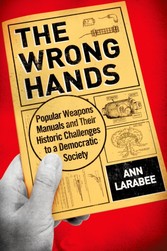Suchen und Finden
Service
Wrong Hands: Popular Weapons Manuals and Their Historic Challenges to a Democratic Society
Ann Larabee
Verlag Oxford University Press, 2015
ISBN 9780190201197
Format ePUB
Kopierschutz DRM
Geräte
[A] valuable account ... The Wrong Hands brilliantly guides us through [the] challenges to American democracy. -Howard P. Segal, Times Higher Education Gun ownership rights are treated as sacred in America, but what happens when dissenters moved beyond firearm possession into the realm of high explosives? How should the state react? Ann Larabees The Wrong Hands, a remarkable history of do-it-yourself weapons manuals from the late nineteenth century to the recent Boston Marathon bombing, traces how efforts to ferret out radicals willing to employ ever-more violent methods fueled the growth of the American security state. But over time, the governments increasingly forceful targeting of violent books and ideas-not the weapons themselves-threatened to undermine another core American right: free expression. In the 1886 Haymarket Square bombing, a new form of revolutionary violence that had already made its mark in Europe arrived in the United States. At the subsequent trial, the judge allowed into evidence Johann Mosts infamous The Science of Revolutionary Warfare, which allegedly served as a cookbook for the accused. Mosts work was the first of a long line of explosive manuals relied on by radicals. By the 1960s, small publishers were drawing from publicly available US military sources to produce works that catered to a growing popular interest in DIY weapons making. The most famous was The Anarchist Cookbook (1971), which soon achieved legendary status-and a lasting presence in the courts. Even novels, such as William Pierces The Turner Diaries, have served as evidence in prosecutions of right-wing radicals. More recently, websites explaining how to make all manner of weapons, including suicide vests, have proliferated. The states right to police such information has always hinged on whether the disseminators have legitimate First Amendment rights. Larabee ends with an analysis of the 1979 publication of instructions for making a nuclear weapon, which raises the ultimate question: should a society committed to free speech allow a manual for constructing such a weapon to disseminate freely? Both authoritative and eye-opening, The Wrong Hands will reshape our understanding of the history of radical violence and state repression in America.
Service
Shop



